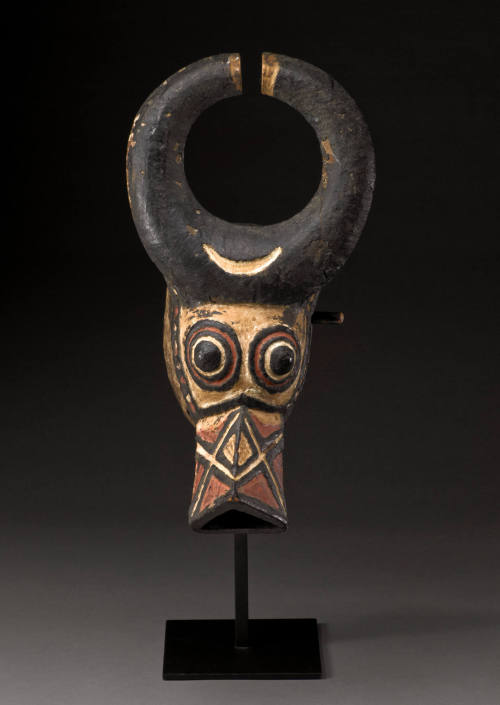Introduction
The African Collection at The Harn Museum is a magnificent collection of works of art that exemplifies the vast range and depth of Sub-Saharan African art history. The collection offers a thorough overview of the development of African art spanning more than two millennia, from the 5th century BCE to the 21st century, representing the shifting socio-cultural dynamics of the continent. The collection stands out for its depth and variety, which spans a wide range of media. It consists of paintings, sculptures made of wood, fabrics, pottery, leather, beading, and metalwork, all representing various dimensions of African artistic expression. This variety demonstrates the creative adaptability of African artists and offers a window into the cultural settings in which different art forms were most successful.
Wooden sculpture is one of the many art styles represented in the collection. These wooden sculptures, mainly consisting of masks and people, are an early and essential group component. They stand as a monument to the continent’s rich cultural legacy since they exemplify traditional African aesthetic values and spiritual beliefs. These statues, frequently finely carved and embellished, were more than just beautiful works of art.
They significantly impacted religious rites, social celebrations, and political gatherings in Africa. As a result, they offer priceless insights into their communities’ social, cultural, and religious systems. The African Collection at the Harn Museum is a colorful tapestry of African art that thoroughly and deeply appreciates the continent’s creative heritage. The collection is a valuable resource for studying and appreciating African art because of its diversity, historical breadth, and high-caliber holdings.
Detailed Analysis of a Selected Art Piece
For the sake of this investigation, this paper will concentrate on a wooden mask that is a prominent component of the African Collection at the Harn Museum. The employment of shows in ceremonial performances and rituals gives them a special place of cultural and spiritual significance in African art. The mask in question is an impressive display of African artistry. Its aesthetic components serve as a showcase for the artistry of its maker.
The mask’s form is meticulously carved to resemble a human face, yet it is styled in a way that goes beyond simple reproduction. Exaggerated and abstract facial features are a recurring theme in African art, giving the piece a feeling of vitality and expressiveness. The influence of the mask’s color is significant.
The wood’s original tones are retained, giving the show an earthy authenticity. The mask’s texture, which was created by meticulous carving and polishing, lends still another level of fascination to the design. The mask’s surface has patterns carved into it that provide a rhythmic interplay of lines and forms that improve its visual appeal.
The mask displays a nice balance between its many aspects in terms of design concepts. The size and arrangement of the mask’s features show the design’s cohesiveness. The mask has a rhythmic element, with recurring themes and patterns giving it a feeling of movement. Although maintaining the proportions of the human face, the mask’s scale is inflated in some places to emphasize them, a method frequently employed in African art to depict various traits or features.
Various techniques are used to make the mask; a carver would have started with a block of wood and progressively removed material to reveal the shape inside to make the sculpture if it had been made of wood. The mask’s surface is covered in elaborate patterns and features that indicate high expertise and accuracy in the carving process. In conclusion, this mask is an exceptional work of art that captures the rich creative traditions of Africa, much like many other objects in the African Collection of the Harn Museum. Its visual components, design concepts, and creative processes influence its aesthetic value and cultural relevance.

Interpretation and Significance
Understanding the cultural and spiritual settings in which African art, such as the chosen mask, was made, is necessary for its interpretation. Masks are more than just aesthetic items in many African communities; they are potent symbols of spiritual and cultural importance. They are frequently utilized in rituals and ceremonies to link the material and spiritual worlds. They often symbolize ancestral spirits, deities, or legendary figures. The mask’s exaggerated features might represent traits like knowledge, bravery, or power.
It is impossible to emphasize the importance of the mask to the African Collection at the Harn Museum and to the larger body of African art. The show is a superb example of African wooden sculpture and exemplifies the aesthetic values and skillfulness that underpin much of African art. It offers a concrete connection to its home community’s extensive cultural and spiritual traditions. The mask adds to the museum’s collection’s range and historical depth, making it an essential resource for the study of and enjoyment of African art.
Conclusion
In conclusion, examining the chosen mask from the African Collection of the Harn Museum provides insightful information about African creative traditions. The aesthetic components, design concepts, and production methods of the cover reveal the talent and ingenuity of its creator. Its symbolic meaning in terms of culture and religion offers insight into the ideals and principles of the civilization in which it was developed. This research highlights the significance of considering African art as essential to the cultural and spiritual history of the continent rather than simply as beautiful artifacts. The diversified and historically significant assets of the African Collection at the Harn Museum are a tribute to the breadth and depth of African art.
Bibliography
Buffalo Mask. n.d.. Web.
Dulal, Lok Nath. “Sculpture of Panchayan Deities of National Museum: An Illustrative Stone Work of Nepal.” International Journal of Culture and History, vol. 9, no. 1, 2022, p. 105. Web.
Elliott, Ben, and Chantal Conneller. “Masks in Context: Representation, Emergence, Motility and Self.” World Archaeology, vol. 52, no. 5, Routledge, 2020, pp. 655–66. Web.
Kanu, Ikechukwu Anthony. African Culture as An Ancient Landmark: Culture Versus Identity. Web.